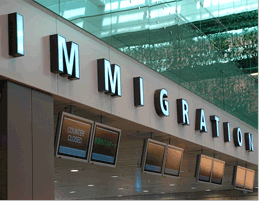Hello everyone! Today’s post is a continuation from last time and will review legalizing documents, police certificates and the physical examination. Let’s get started:
Note: The requirements below are for the Alien Fiancé(e), NOT for the U.S. Citizen. Meaning the U.S. citizen does not need to gather these documents or have a medical exam.
k
Legalizations
j
What are legalizations?
Like I explained in my last post, you need to get certificates (that you will send to the U.S. embassy) legalized. Legalizations are done to make sure that certain legal certificates are official and not fake.
j
What do I need to get legalized?
You need to get any certificate (birth, marriage, divorce, and death certificates) that come from the foreigner's country legalized.
Note: You may not need to get a certificate legalized if they do not apply to your specific situation. For example, my fiance has never been married, so we did not need to get a marriage, divorce, or death certificate legalized.
j
How do I get certificates legalized?
You should first call the place where you can get the certificate legalized to see if you need to make an appointment before coming in. In some cases you can mail the certificates in and they will legalize it then send it back.
j
Where do I get documents legalized?
Argentina: Ministry of Internal Affairs of Argentina located at: Calle 25 de Mayo 179, Capital Federal. To legalize your certificates in Buenos Aires you need to have previously legalized them in your province’s Registro Civil. For example, my fiance got his birth certificate in the county house (registro civil municipal) of the city where he lives, then legalized it at Dirección General de Registro Civil de La Provincia de Córdoba (the province he lives in).
Other Countries: This location may differ in each country, but if it is the Ministry of Internal Affairs of the foreigner's country you can click here to see a list of the locations of other countries’ Ministries of Internal Affairs.
Note: You should receive the exact address of the place where you can get documents legalized once you get the K1 Application Instructions packet in your email.
Police Certificate
j
What is a police certificate?
A police certificate is a document from the police explaining any crimes that the alien fiancé(e) may have committed (or not committed). Your fiancé(e) will need a certificate for each of the countries that he or she has lived in.
j
How do I obtain a police certificate?
Argentina: To obtain a police certificate you must go to the “Registro Nacional de Reincidencia” website and make an appointment. After this you will get an email confirmation of your appointment and a form that you need to complete and print to bring with you. Once you go to your appointment (you can go there up to 45 minutes before your scheduled time) you will pay a fee (you must pay in cash) if you didn’t already pay online or in the bank. They will then fingerprint you. After this you must (before you sign) tell the person “con excepción al artículo 51 del Código Penal”. He or she will then tell you where to write that statement before signing. Once you finish he or she will give you a receipt. With this data you will be able to access your certificate online, which you will be able to print. This certificate is electronically signed. This is the original certificate that you will bring to the interview. This is important to note, as one may think that they have to go in again to get a non-electronic signature, which is NOT the case in Argentina.
Note: When you are completing the online form you need to select how much time after your appointment you want to be able to view your certificate online. You will pay a higher price the sooner you want to be able to view it.
j
Other Countries: The process may vary in each country. The exact process will be described in the K1 Application Instructions packet.
j
Where do I obtain a police certificate?
Argentina: “Registro Nacional de Reincidencia” of the Federal Ministry of Justice and Human Rights at Tucumán 1353, Ciudad Autónoma de Buenos Aires.
Note: Even if you are from another province in Argentina you need to get the police certificate at the Buenos Aires location listed above.
j
Other Countries: The location will vary in each country. The exact location will be listed in the K1 Application Instructions packet.
Physical examination
j
Who can give me my physical exam?
Argentina:
Note: You will be able to communicate and coordinate your appointment with the doctor you select. My fiance was able to get the whatsapp number of the doctor and she answered all of the questions he had.
Other Countries: There are specific doctors in each country that are qualified to give this exam. You will need to wait until you receive the K1 Application Instructions packet to get an exact list of the doctors.
j
What vaccines are required to enter the U.S.?
Mumps, Measles, Rubella, Polio, Tetanus and diphtheria toxoids, Pertussis, Haemophilus influenzae type B (HIB), Hepatitis B, Varicella, Pneumococcal, Influenza, Rotavirus, Hepatitis A and Meningococcal.
Tips:
*You should get all of the required vaccines BEFORE going to your medical exam. Not having all of the vaccines before you go will slow down the process.
*Call the doctor to ask if you can get everything done in one day. The reason this process may take more than one day is because after you go to the doctor’s the first time, you will then be sent to get your blood tested and X-Rays of your chest (this is sometimes located at a separate doctor’s office!). After doing all of this you will need to wait until your results have been sent back to the doctor so he or she can include that in your medical exam report. Since my fiance lives 8 hours away from Buenos Aires (where the doctors are located in Argentina) he called ahead of time to request that it all be taken care of in one day.
j
Note: Your approved medical exam will be put into a sealed envelope. You will be required to send the embassy a photocopy of the front side of the envelope as evidence that you have completed the Medical Exam. You will then bring the sealed envelope to the interview. If that envelope shows signs of tampering or has been opened it will not be accepted.
j
*Remember: You will have to send COPIES of all of these documents/certificates (and the ones listed on my last post) to the U.S. embassy and bring the ORIGINALS to the interview.




